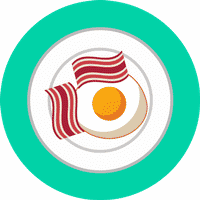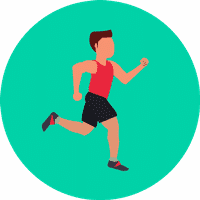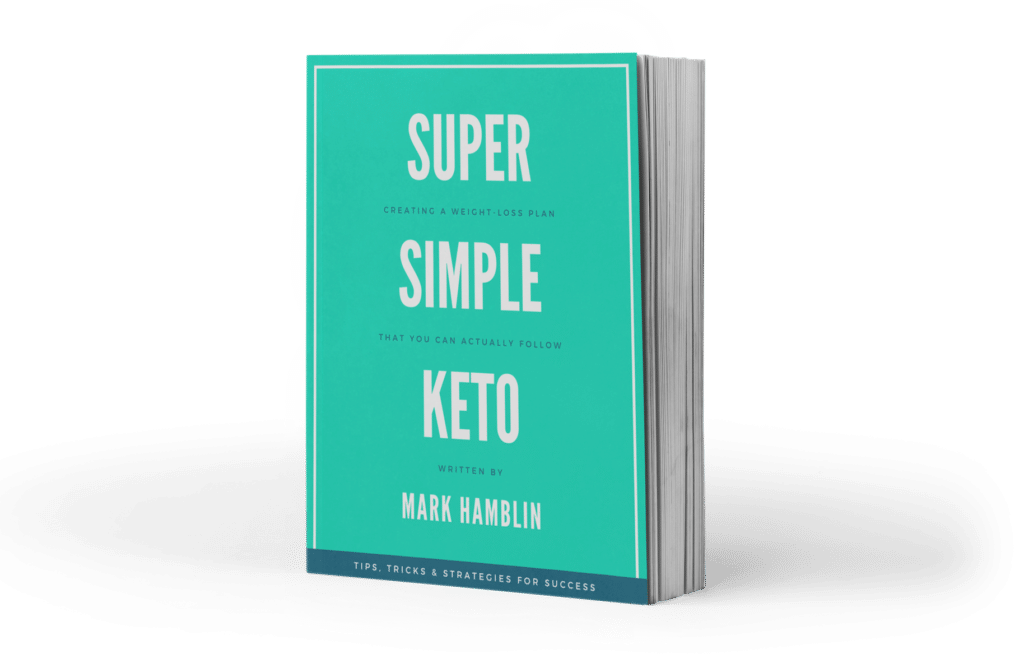The Ultimate One-Page Guide to the Keto Diet
Just about everything you need to know about the Ketogenic Diet... on one page.
JUMP TO EACH SECTION

What the **** is Keto?
The Ketogenic Diet, commonly called "Keto", is a particular way of eating that puts your body into a state of "nutritional ketosis." In ketosis, your body uses fat as its primary fuel source -- either fat that you eat, or fat from your own stored body fat.
A typical Ketogenic Diet consists of a very low amount of carbohydrates, moderate amounts of protein, and relatively high amounts of fat. A typical macronutrient ratio (in calories) is less than 5% from carbohydrates, 20%-30% from protein, and ~75% from fat.
When carbohydrates are highly restricted, your body no longer has any stored glucose to "burn" for energy so it starts to use fat instead. Your muscles and other tissues do not burn the fat directly, instead the fat (either eaten or stored) is metabolized (processed) in your liver, and this process produces "ketones". Your cells then use these ketones as their energy source. Hence the name, the "Ketogenic Diet".
The Ketogenic Diet has many scientifically proven benefits. It was first developed in the 1920's as a way to treat epilepsy, and is still used for this purpose today. Since then, it has been, and continued to be studied for uses in treating obesity, diabetes, cancer, Alzheimer's disease, and many other medical conditions. It has significantly grown a mainstream following of people who have effectively used it for weight loss.
Keep reading below for more information on what to eat on a Ketogenic Diet, what benefits to expect, scientific references, and a list of Frequently Asked Questions.

What to eat (and not eat) on a Ketogenic Diet?
This is often the place where people get the most confused, but it's really quite simple. It's easier to begin talking about the foods you should NOT eat while on a Ketogenic Diet since entering and staying in ketosis is primarily done by restricting certain foods (carbs) instead of adding new ones.
What NOT to Eat
Put simply, to get into and maintain nutritional ketosis, you need to avoid carbohydrates. These carbohydrates get broken down into glucose in our bodies, and/or get stored as glycogen in our livers. When this happens we can't be in ketosis, and therefore can't be burning fat for fuel.
Glucose = bad for keto.
There are many "types" of carbohydrates, and often people think of "good carbs" and "bad carbs". For example, people often think that eating some brown rice or fruit is "good for you", but eating a candy bar is "bad." That's not necessarily true...
We'll agree that the brown rice isn't as bad for you as a candy bar, but when following a ketogenic diet, nearly all carbs are "bad carbs." Inside your body, the carbs from that brown rice get broken down into the same glucose as the candy bar. It's similar with fruit also - the sugars in fruit (both glucose and fructose) also get broken down into glucose and stored as glycogen in our livers. Different sources, but same end result - it's all bad for entering and staying in ketosis.
What You CAN Eat on a Ketogenic Diet
The best foods to eat on a ketogenic diet are healthy fats, protein, and low-carb vegetables (think salad vegetables). And there are many wonderful, delicious foods that fall into this category. Things like cheese, fish, beef, pork, spinach, broccoli, nuts, seeds, and many more.
Many of these foods were labeled as "un-healthy" during the low-fat craze of the last ~50 years, but with the recent (well justified) resurgence of low-carb diets, things are starting to change. Keto diet beginners may have to re-calibrate their instincts when it comes to these foods -- what you were once taught was un-healthy may actually be the thing that saves you, just like it did for me.
Other Things You SHOULD Eat on a Ketogenic Diet
SALT & ELECTROLYTES: When in ketosis, your body does not store as much electrolytes (salts), so most people need to increase their intake of these minerals to maintain healthy levels. Personally, I don't take any salt or electrolyte supplements, I just put salt on most things I eat, which is enough for me.
WATER: Your body needs of water while in ketosis to help with fat metabolism. When in ketosis, your body does not store as much water (which is why you see may see a big drop in weight when starting Keto). You don't necessarily need to drink a gallon per day, but be sure not to cut back either. Drinking water can help you feel full also.
The Keto Food List
(A complete interactive version of this list is also available here.)
The list of foods below is a comprehensive guide to the foods you CAN and CAN NOT eat while following a ketogenic diet. We believe it's just as important to highlight the foods you can't eat as it is to list the ones you can.
We also believe that following a ketogenic diet is not completely black and white -- there are certain foods that are OK in moderation, and/or once you've been in ketosis for some time. While it's best to keep carbs as low as possible, we are also realistic human beings -- sometimes we don't have perfect food options, and sometimes we have to choose between the lesser of two evils.
DEFINITIONS
OK to Eat
Sometimes / Sparingly
Never Eat
THE LIST
Click on each category to expand the section.
Many vegetables are Keto-friendly! You'll want to make vegetables a big part of your diet.
In general, vegetables that grow above-ground are Keto-friendly, while those that grow below-ground are not. Examples of below-ground vegetables are potatoes, sweet potatoes, and even carrots (although not bad).
When looking at nutrition information for vegetables, it is generally safe to subtract their fiber content from the total carbohydrate count, as fiber is not as easily processed by the body, so one gram of fiber does not have the same effect on blood sugar as one gram of sugar.
OK to Eat
- Artichoke
- Arugula
- Asparagus
- Broccoli & Broccoli Rabe
- Brussel Sprouts
- Cabbage
- Cauliflower
- Celery
- Chard / Swiss Chard
- Cucumber
- Eggplant
- Endive
- Fennel
- Garlic
- Green Beans / String Beans
- Jalapeno
- Jicama
- Kale
- Lettuce
- Mushrooms
- Okra
- Parsley
- Pepper (Bell)
- Radish
- Snow Peas / Peapods
- Spaghetti Squash
- Spinach
- Zucchini
Sometimes / Sparingly
- Carrots
- Onions
- Pumpkin
- Shallots
- Soybeans
- Turnips
- Tomato (really a fruit)
Never Eat
- Butternut Squash
- Potatoes
- Sweet Potatoes
- Corn
Most fruits are not keto-friendly. Despite having many vitamins and minerals, they simply have too much sugar.
For example, one medium size apple has ~20 grams of sugar, and it will likely knock you out of ketosis for a short bit.
Many berries are lower in sugar than other fruits, although they should be used sparingly, and not eaten in the first ~ 2 weeks of starting a ketogenic diet while you are trying to become fat adapted. Certainly don't go and eat an entire pint of strawberries -- that has 17g of sugar!
OK to Eat
- Avocado
- Lemon
- Lime
- Olives
Sometimes / Sparingly
- Raspberries
- Blackberries
- Strawberries
- Blueberries
- Tomatoes
- Rhubarb (without sugar)
- Cranberries (without sugar)
Never Eat
- Apples
- Bananas
- Plantain
- Oranges
- Cherries
- Grapes
- Raisins
- Grapefruit
- Pear
- Plum
- Kiwi
- Peach / Nectarine
- Mango
- Papaya
- Canteloupe
- Watermelon
- Other Melons
- Pineapple
- Most other fruits!
Just about all meats & fish are Keto-friendly.
When shopping for them, the key thing to check is whether or not they come with any added sugars or carbs in the form of fillers, sauces, or marinades. If you're buying fresh, un-flavored meats and fish, then you're fine!
One of the great things about the Ketogenic Diet is that you do not have to limit your choices to "lean" proteins. Things like bacon, fatty cuts of beef, and organ meats are great choices on Keto -- they taste great, there are a lot of nutrients in the fat and organ meats, and they'll help you feel full.
OK to Eat
- Eggs (all kinds!)
- Pork Products
- Pork (any cut)
- Bacon (make sure no added sugars)
- Prosciutto
- Pork Sausage (check carb counts)
- Breakfast Sausage (watch for added sugars)
- Beef Products
- Beef (any cut, grass-fed is great, but not necessary)
- Beef Jerky (low-carb versions)
- Hamburger Patties & Ground Beef
- Poultry Products
- Chicken (dark meat is best)
- Chicken Wings (without breading or sweet sauces)
- Turkey (dark meat is best)
- Other poultry (quail, goose, duck, pheasant)
- Seafood
- Fish (fattier types are best)
- Shellfish (crab, lobster, etc.)
- Oysters
- Mussels
- Anchovies (in the can)
- Other
- Wild Game (venison, elk, wild boar, etc.)
Sometimes / Sparingly
- The items on this list are only OK (green category) if they are specifically made with low-carb ingredients. Check the label before buying them!
- Meatballs, pre-made (unless specifically low-carb)
- Meatloaf (unless specifically low-carb)
- Chicken Sausage, pre-made (most have added carbs)
- Beef Jerky (most have added sugar, check nutrition label)
- BBQ Ribs (unless specifically using low-carb BBQ sauce)
- Tofu (even though it has low carbs, soy has high amounts of poly-unsaturated oils)
Never Eat
- Meats with sweet sauces (marinades, BBQ sauce, teriyaki flavored beef jerky, etc.)
- Meats with breadcrumb and sugar fillers (meatballs, meatloaf, sweet sausages, etc.)
- Meats/fish with fried breading (fried chicken, chicken strips, fish sticks, battered chicken wings, chicken-fried steak, etc..)
In general, fats are a great thing to eat on the Ketogenic Diet. After all, eating fat is not what makes you fat (that's carbs) so you can even add extra fats to things likes vegetables to make them taste great!
But of course, not all fats are created equal. Some are excellent choices as they have great nutrients, great fatty acid makeups, and they're very tasty. But other fats are actually not great because they have the wrong types of fatty acids that actually do more harm to your body than help.
Some Keto people claim there are some fats that you absolutely cannot have -- like Soybean Oil, Canola Oil, and other seed-based oils. While I certainly agree these fats are not nearly as good as other options, I put them on the "yellow" list, as they are so common in our everyday foods, and completely eliminating them from a Ketogenic Diet puts unnecessary restrictions on a diet that is already a bit difficult to maintain. Use those fats in moderation, but if they're you're only option, you'll be OK.
OK to Eat
- Butter
- Ghee
- Lard
- Schmaltz / Chicken Fat
- Duck Fat / Goose Fat
- Fish Oil
- Olive Oil
- Avocado Oil
- Coconut Oil
- Most Other Nut Oils
Sometimes / Sparingly
- All of these oils should be avoided when possible, but are not going to knock you out of Ketosis if you have them. They are mainly on this list because they are low-quality, not because they have carbs.
- Sunflower Oil
- Canola Oil
- Soybean Oil (most common in salad dressings)
- Safflower Oil
- Peanut Oil
- Corn Oil
- Margerine (usually made with Canola Oil)
Never Eat
- Try your best to avoid the fats in the yellow column.
Nuts are an excellent Keto-friendly food choice. But not all nuts are created equal, and you MUST watch your quantity when eating nuts. Nuts are very calorically dense and all of them still contain some carbs, and its so easy to get carried away and overeat. Don't do that.
You also watch out when buying flavored or processed nut products, as they often contain sweeteners or other hidden carbs. For example, while almonds themselves are great, "honey-roasted" almonds are a no-no. As always, be sure to check the label before you buy!
OK to Eat
- Nuts
- Almonds
- Brazilnuts
- Coconut (unsweetened)
- Hazelnuts
- Macadamia Nuts
- Pecans
- Pili Nuts
- Walnuts
- Seeds
- Chia Seeds
- Flax Seeds
- Hemp Seeds
- Pumpkin Seeds / Pepitas
- Sesame Seeds
- Sunflower Seeds
- Nut/Seed Butters
- Almond Butter (unsweetened)
- Sunflower Butter (unsweetened)
Sometimes / Sparingly
- Peanuts (NOT honey roasted)
- Peanut Butter (natural, without sugar)
- Cashews
- Cashew Butter (natural, without sugar)
- Pistachios
Never Eat
- Beans (any kind)
- Chickpeas
- Hummus
- Peanut Butter (the regular kind with lots of sugar)
- Almond Butter, sweetened (check the label!)
All typical "bread" type products are off-limits on Keto, as these foods are made of nearly 100% carbohydrates.
The good news is that there are alternatives! Many bread-based foods can be made with almond flour, coconut flour, and other Keto-friendly alternative ingredients. But even with these alternatives, you need to be careful! The carb counts can creep up quite a bit, even with almond flour. If you eat a big stack of "Keto-friendly" pancakes with sugar free syrup, the net carb count can still easily reach over 20 grams if you eat too much!
And definitely watch-out for "low-carb" or "Smart-Carb" versions of bread products sold at major supermarkets. While they may be lower carb versions, they often still have a surprisingly high amount of carbs per serving.
Personally, I view these alternative flours as infrequent indulgences, not as something to eat every day.
OK to Eat
- All of these should be consumed in moderation!
- Almond Flour / Almond Meal
- Cocoa Powder (unsweetened)
- Coconut Flour
- Flax Seed Meal
- Protein Powders (very low-carb versions only)
- Psyllium Husk
- Sesame Seed Flour
- Shiritaki Noodles
Sometimes / Sparingly
- While many of these are labeled as "low-carb" most of them still have a relatively high amount of carbs per serving.
- Low-carb baking mixes (most still have high carb counts)
- Low-carb breads (check the nutrition label)
- Low-carb tortillas (check the nutrition label)
- Low-carb pastas (check the nutrition label)
- Low-carb baked goods (use these sparingly, not every day)
Never Eat
- Rice
- Pasta
- Noodles
- Wheat
- Bread (yes, even whole wheat)
- Oats
- Oatmeal
- Quinoa
- "Carb-Smart" Breads & Torillas (they still have so many carbs!)
- Tapioca Flour or Tapioca Balls (found in bubble teas)
Dairy causes a lot of confusion with newcomers to Keto. Some people seem to have better results completely avoiding dairy, while other (myself included) do great with dairy included. It comes down to personal choice and experimentation.
But one thing is certain -- you need to avoid a lot of the mainstream dairy products like regular milk and most yogurt. These foods have a surprising amount of carbs!
You also need to be very careful that processed dairy foods and dairy substitutes don't have added carbs. For example, while full-fat plain greek yogurt is OK to eat, most greek yogurt sold in stores is sweetened and flavored, which has LOTS of sugar. Read the labels! Keto people claim there are some fats that you absolutely cannot have -- like Soybean Oil, Canola Oil, and other seed-based oils.
In general, stick with cheeses, heavy whipping cream, and sugar-free dairy substitutes and you'll be fine.
OK to Eat
- Dairy Products
- Heavy Whipping Cream / Heavy Cream
- Butter
- Plain Greek Yogurt (full-fat is best)
- Cheese (just about any kind!)
- Cream Cheese (make sure it has no added sweet flavors like honey)
- Sour Cream
- Dairy Substitutes
- Almond Milk (unsweetened)
- Coconut Milk (unsweetened)
- Macadamia Milk (unsweetened)
- Coconut Cream (unsweetened)
Sometimes / Sparingly
- Cottage Cheese (unsweetened)
- Whipped Cream (the kind in the can)
- Soy Milk (unsweetened, not great, but not the worst thing you can have)
- Sugar-free Soy Milk Ice Cream (occasionally, in moderation)
Never Eat
- Milk (too many carbs!)
- Half-and-Half
- Yogurt (except Plain Greek Yogurt)
- Flavored Greek Yogurt
- Fruit/Sweet Flavored Cream Cheeses
- Flavored Coffee Creamers (some rare exceptions)
- Ice Cream (yes, even Halo-Top)
- Frozen Yogurt
Beverages are a pretty easy thing to manage while on a Ketogenic Diet. The main thing to check for is the use of any sugars or artificial sweeteners on the ingredient label.
In general, follow the rules in the Sweeteners section of this guide.
You will want to stay away from any sugar-based sweeteners, even if they are "natural", like cane-sugar, honey, agave, and fruit juice.
OK to Drink
- Coffee
- Tea
- Sparking Water / Soda Water
- Almond Milk (see above for other dairy substitutes)
- Bone Broth
Sometimes / Sparingly
- These beverages are in the "sometimes" category because of the artificial sweeteners they use.
- Diet Soda
- Crystal Light
- Powerade Zero
- Other sugar-free sweetened drinks
- Red Wine (1 glass)
- Hard Liquor (watch your mixer)
Never Drink
- Regular Soda
- Tonic Water
- Fruit Juice
- Vegetable Juices / V8 Juice
- Carrot Juice
- Beer (even lower-carb beer)
- White Wine
- Fruity Alcoholic Drinks
There are many alternative or artificial sweeteners available on the market today that provide similar sweetness to sugar, but without the calories, carbohydrates, and impacts on insulin. But should you include these in your Ketogenic Diet? There is much debate in the community.
I personally advocate for staying away from ALL sweeteners as much as possible, and this is what I do myself. Why? Not because of the impact these sweeteners may or may not have on insulin, but rather because they cause me to overeat.
If you are the type that can limit your overall consumption, even if it is sweet, then go ahead and use some of these sweeteners. But be careful, as many people often notice stalls in their weight-loss when they include too many sweeteners in their diet.
OK to Eat
- I advocate for staying away from all sweeteners, artificial, carb-free, or otherwise. This helps avoid overeating, binge eating, and weight-loss stalls. However, if you're going to indulge, these are the better ones to use:
- Erythritol
- Stevia
- Monk Fruit Extract
- Allulose
Sometimes / Sparingly
- These sweeteners are still generally OK to use, but they all should be used in very limited quantities. Choose the ones from the green list if possible, especially for baking, and things that use more quantity.
- Sucralose
- Aspartame (common in diet sodas, may cause other health issues)
- Swerve (a brand of mostly Erythritol, but with other additives)
- Xylitol (it's also very poisonous for dogs!)
- Dark Chocolate (at least 80%)
Never Eat
- Sugar(white & brown)
- Honey
- Agave
- Molasses
- Corn Starch
- Corn Syrup
- Maltitol (Frequently used in Atkins-brand products, protein bars, etc. Can spike insulin and blood glucose and causes GI upset. Stay away.)
- Other sugar substances:
- Dextrose
- Lactose
- Maltodextrin
Dressings and sauces are one of the top places where food companies put "hidden" carbs, and often where a lot of Keto newcomers go wrong. And the "low-fat" craze of the past 50 years has taught people (incorrectly) that low-fat salad dressings are the way to go. Definitely not the case with the Ketogenic Diet.
There are so many great low-carb and zero-carb dressings and sauces coming to market, so there's no reason to use the sugar-filled ones. If BBQ sauce is your thing, for example, there are many great low-carb versions now available.
Another key point with dressings and sauces is to check which oils are used. Most store-bought dressings are based on Soybean or Canola Oil, which is not a great choice. Seek out dressings made with Avocado Oil if possible.
If there is one piece of advice for dressings and sauces, its that you should read the label! This is the case with any food, but particularly important for dressings and sauces.
OK to Eat
- Wine Vinegar (red or white)
- Apple Cider Vinegar
- Ranch Dressing (full-fat versions)
- Bleu Cheese Dressing (full-fat versions)
- Caesar Dressing (full-fat versions)
- Mayonnaise (most are vegetable oil-based, which is not great)
- Hot Sauce
- Sriracha Sauce (Rooster Sauce)
Sometimes / Sparingly
- Balsamic Vinegar (it actually has quite a bit of sugar)
- Low-Carb BBQ Sauces (most still have quite high amounts of carbs)
Never Eat
- BBQ Sauce (regular kind)
- Thousand Island Dressing
- French / "Catalina" Dressing
- Most "Fat Free" Salad Dressings (they're full of sugar!)
Snack foods can be hard to categorize, so I made a dedicated section just for them.
There are so many new snack foods coming on the market that claim to be low-carb or Keto-friendly -- some are, and some are not. And some are OK, but only in moderation.
Just like with artificial sweeteners, you need to be careful not to overeat some of these foods, even the Keto-friendly ones. Eating too much quantity, even if it is "approved", can lead to weight-loss stalls and frustration.
Watch your intake, and as always, read the label!
OK to Eat
- Beef Jerky, low-carb versions only
- Dried Sausage Snacks (check carb counts)
- Pork Rinds / Chiccarones / Cracklins
- Nuts (see "Nuts & Seeds" section above)
- Seeds (sunflower, pumpkin, etc.)
- Salami / Pepperoni slices (check for hidden carbs)
- Prosciutto
- Cheese Sticks / String Cheese
- Cut Vegetables (broccoli, cauliflower, peppers, etc.)
Sometimes / Sparingly
- Peanuts, dry-roasted
- Beef Jerky, most store-bought versions (usually have a lot of added sugars)
- Quest Protein Bars
- Low-Carb Cookies (Keto Kookies, Nui Cookies, Quest Cookies, etc.)
- Other pre-made low-carb sweets (OK once in a while)
Never Eat
- Potato Chips
- Veggie Chips (almost all brands are still potato based)
- Pea Crisps (a particular brand, still starch-based)
- Pretzels
- Peanuts, honey-roasted
- Beef Jerky, sweet flavors
- Anything else carb-based!

How much should you eat on a Ketogenic Diet?
Vestibulum ac diam sit amet quam vehicula elementum sed sit amet dui. Curabitur aliquet quam id dui posuere blandit. Vivamus suscipit tortor eget felis porttitor volutpat. Vivamus magna justo, lacinia eget consectetur sed, convallis at tellus. Praesent sapien massa, convallis a pellentesque nec, egestas non nisi. Vestibulum ac diam sit amet quam vehicula elementum sed sit amet dui.
Cras ultricies ligula sed magna dictum porta. Vivamus magna justo, lacinia eget consectetur sed, convallis at tellus. Vivamus magna justo, lacinia eget consectetur sed, convallis at tellus. Mauris blandit aliquet elit, eget tincidunt nibh pulvinar a. Curabitur arcu erat, accumsan id imperdiet et, porttitor at sem. Sed porttitor lectus nibh.
Vivamus magna justo, lacinia eget consectetur sed, convallis at tellus. Vestibulum ac diam sit amet quam vehicula elementum sed sit amet dui. Vivamus magna justo, lacinia eget consectetur sed, convallis at tellus. Praesent sapien massa, convallis a pellentesque nec, egestas non nisi. Sed porttitor lectus nibh. Nulla porttitor accumsan tincidunt.

Do you need to exercise while doing Keto?
Vestibulum ac diam sit amet quam vehicula elementum sed sit amet dui. Curabitur aliquet quam id dui posuere blandit. Vivamus suscipit tortor eget felis porttitor volutpat. Vivamus magna justo, lacinia eget consectetur sed, convallis at tellus. Praesent sapien massa, convallis a pellentesque nec, egestas non nisi. Vestibulum ac diam sit amet quam vehicula elementum sed sit amet dui.
Cras ultricies ligula sed magna dictum porta. Vivamus magna justo, lacinia eget consectetur sed, convallis at tellus. Vivamus magna justo, lacinia eget consectetur sed, convallis at tellus. Mauris blandit aliquet elit, eget tincidunt nibh pulvinar a. Curabitur arcu erat, accumsan id imperdiet et, porttitor at sem. Sed porttitor lectus nibh.
Vivamus magna justo, lacinia eget consectetur sed, convallis at tellus. Vestibulum ac diam sit amet quam vehicula elementum sed sit amet dui. Vivamus magna justo, lacinia eget consectetur sed, convallis at tellus. Praesent sapien massa, convallis a pellentesque nec, egestas non nisi. Sed porttitor lectus nibh. Nulla porttitor accumsan tincidunt.

Measuring Progress while on a Ketogenic Diet
Vestibulum ac diam sit amet quam vehicula elementum sed sit amet dui. Curabitur aliquet quam id dui posuere blandit. Vivamus suscipit tortor eget felis porttitor volutpat. Vivamus magna justo, lacinia eget consectetur sed, convallis at tellus. Praesent sapien massa, convallis a pellentesque nec, egestas non nisi. Vestibulum ac diam sit amet quam vehicula elementum sed sit amet dui.
Cras ultricies ligula sed magna dictum porta. Vivamus magna justo, lacinia eget consectetur sed, convallis at tellus. Vivamus magna justo, lacinia eget consectetur sed, convallis at tellus. Mauris blandit aliquet elit, eget tincidunt nibh pulvinar a. Curabitur arcu erat, accumsan id imperdiet et, porttitor at sem. Sed porttitor lectus nibh.
Vivamus magna justo, lacinia eget consectetur sed, convallis at tellus. Vestibulum ac diam sit amet quam vehicula elementum sed sit amet dui. Vivamus magna justo, lacinia eget consectetur sed, convallis at tellus. Praesent sapien massa, convallis a pellentesque nec, egestas non nisi. Sed porttitor lectus nibh. Nulla porttitor accumsan tincidunt.

The Science Behind the Ketogenic Diet
Vestibulum ac diam sit amet quam vehicula elementum sed sit amet dui. Curabitur aliquet quam id dui posuere blandit. Vivamus suscipit tortor eget felis porttitor volutpat. Vivamus magna justo, lacinia eget consectetur sed, convallis at tellus. Praesent sapien massa, convallis a pellentesque nec, egestas non nisi. Vestibulum ac diam sit amet quam vehicula elementum sed sit amet dui.
Cras ultricies ligula sed magna dictum porta. Vivamus magna justo, lacinia eget consectetur sed, convallis at tellus. Vivamus magna justo, lacinia eget consectetur sed, convallis at tellus. Mauris blandit aliquet elit, eget tincidunt nibh pulvinar a. Curabitur arcu erat, accumsan id imperdiet et, porttitor at sem. Sed porttitor lectus nibh.
Vivamus magna justo, lacinia eget consectetur sed, convallis at tellus. Vestibulum ac diam sit amet quam vehicula elementum sed sit amet dui. Vivamus magna justo, lacinia eget consectetur sed, convallis at tellus. Praesent sapien massa, convallis a pellentesque nec, egestas non nisi. Sed porttitor lectus nibh. Nulla porttitor accumsan tincidunt.

Huh? I'm Confused!? What about....?
Vestibulum ac diam sit amet quam vehicula elementum sed sit amet dui. Curabitur aliquet quam id dui posuere blandit. Vivamus suscipit tortor eget felis porttitor volutpat. Vivamus magna justo, lacinia eget consectetur sed, convallis at tellus. Praesent sapien massa, convallis a pellentesque nec, egestas non nisi. Vestibulum ac diam sit amet quam vehicula elementum sed sit amet dui.
Cras ultricies ligula sed magna dictum porta. Vivamus magna justo, lacinia eget consectetur sed, convallis at tellus. Vivamus magna justo, lacinia eget consectetur sed, convallis at tellus. Mauris blandit aliquet elit, eget tincidunt nibh pulvinar a. Curabitur arcu erat, accumsan id imperdiet et, porttitor at sem. Sed porttitor lectus nibh.
Vivamus magna justo, lacinia eget consectetur sed, convallis at tellus. Vestibulum ac diam sit amet quam vehicula elementum sed sit amet dui. Vivamus magna justo, lacinia eget consectetur sed, convallis at tellus. Praesent sapien massa, convallis a pellentesque nec, egestas non nisi. Sed porttitor lectus nibh. Nulla porttitor accumsan tincidunt.
JOIN THE KETOJAM FAMILY
Subscribe to the KetoJam newsletter for all of our new recipes, program updates, and our exclusive discounts on our training and coaching programs.


